Product Lifecycle Strategy Analysis
VerifiedAdded on 2023/05/30
|12
|3098
|127
AI Summary
This report analyzes the ways in which manufacturers of Apple Inc’s iPhone 5 change their strategic decisions for reduction and supply of goods at each stage of the product lifecycle in consideration to certain factors.
Contribute Materials
Your contribution can guide someone’s learning journey. Share your
documents today.
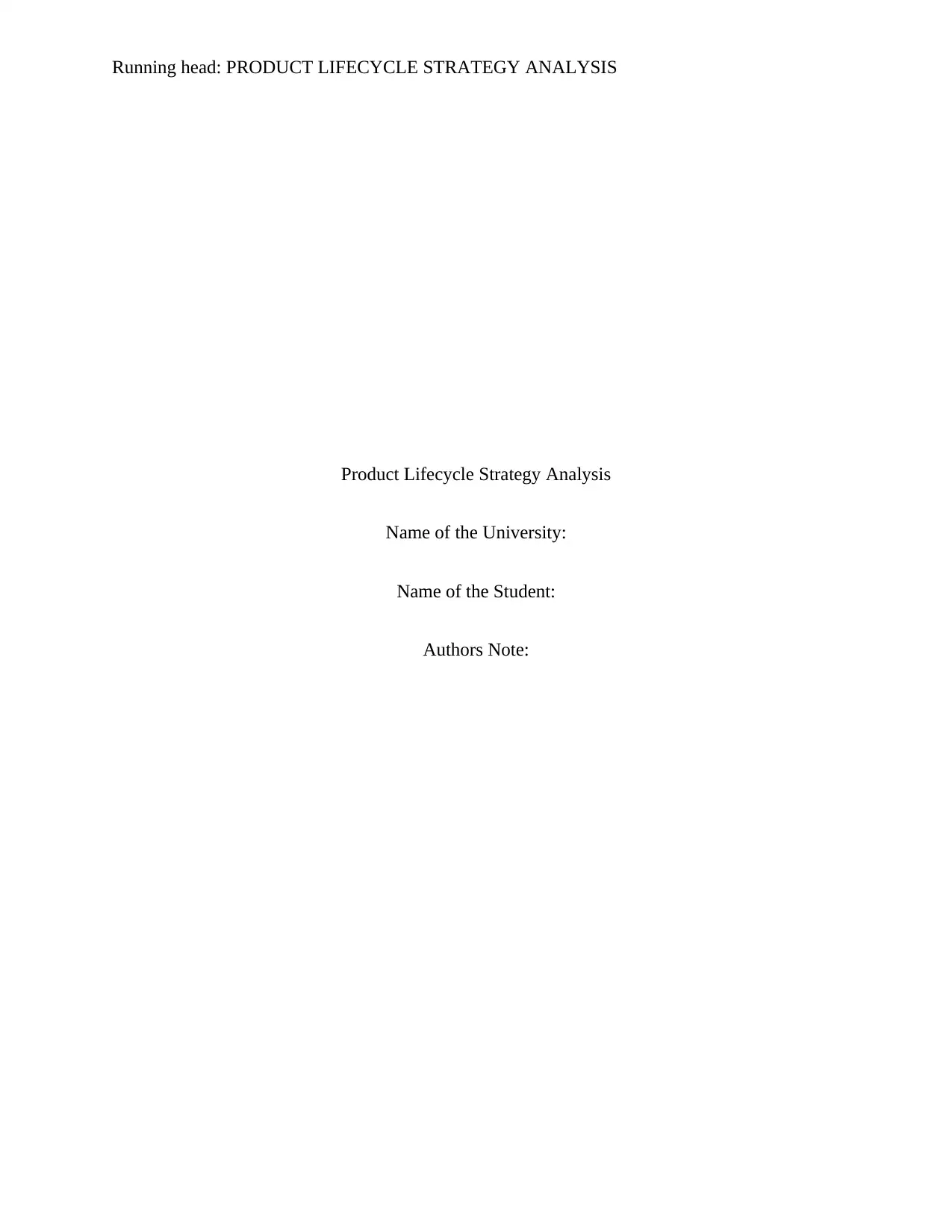
Running head: PRODUCT LIFECYCLE STRATEGY ANALYSIS
Product Lifecycle Strategy Analysis
Name of the University:
Name of the Student:
Authors Note:
Product Lifecycle Strategy Analysis
Name of the University:
Name of the Student:
Authors Note:
Secure Best Marks with AI Grader
Need help grading? Try our AI Grader for instant feedback on your assignments.
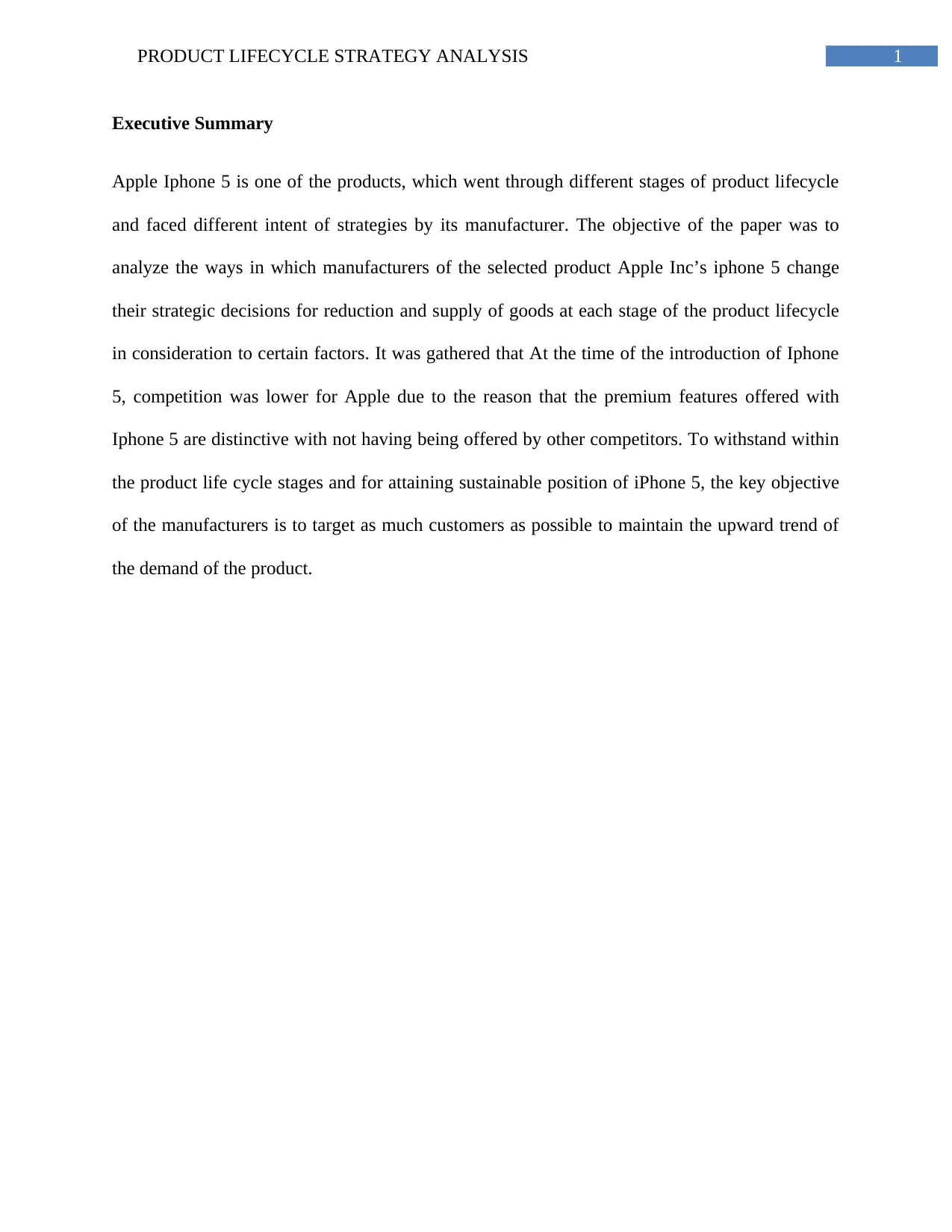
1PRODUCT LIFECYCLE STRATEGY ANALYSIS
Executive Summary
Apple Iphone 5 is one of the products, which went through different stages of product lifecycle
and faced different intent of strategies by its manufacturer. The objective of the paper was to
analyze the ways in which manufacturers of the selected product Apple Inc’s iphone 5 change
their strategic decisions for reduction and supply of goods at each stage of the product lifecycle
in consideration to certain factors. It was gathered that At the time of the introduction of Iphone
5, competition was lower for Apple due to the reason that the premium features offered with
Iphone 5 are distinctive with not having being offered by other competitors. To withstand within
the product life cycle stages and for attaining sustainable position of iPhone 5, the key objective
of the manufacturers is to target as much customers as possible to maintain the upward trend of
the demand of the product.
Executive Summary
Apple Iphone 5 is one of the products, which went through different stages of product lifecycle
and faced different intent of strategies by its manufacturer. The objective of the paper was to
analyze the ways in which manufacturers of the selected product Apple Inc’s iphone 5 change
their strategic decisions for reduction and supply of goods at each stage of the product lifecycle
in consideration to certain factors. It was gathered that At the time of the introduction of Iphone
5, competition was lower for Apple due to the reason that the premium features offered with
Iphone 5 are distinctive with not having being offered by other competitors. To withstand within
the product life cycle stages and for attaining sustainable position of iPhone 5, the key objective
of the manufacturers is to target as much customers as possible to maintain the upward trend of
the demand of the product.
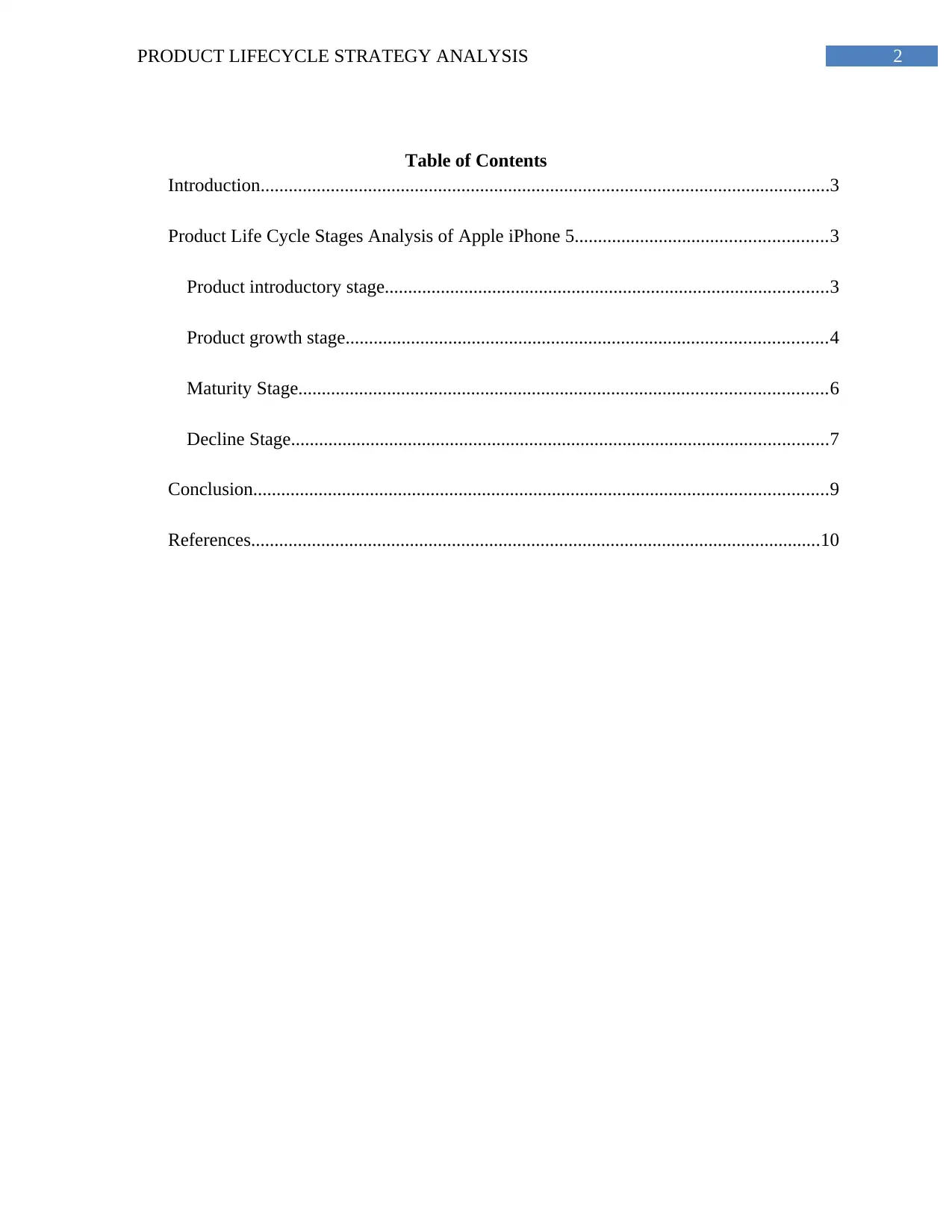
2PRODUCT LIFECYCLE STRATEGY ANALYSIS
Table of Contents
Introduction..........................................................................................................................3
Product Life Cycle Stages Analysis of Apple iPhone 5......................................................3
Product introductory stage...............................................................................................3
Product growth stage.......................................................................................................4
Maturity Stage.................................................................................................................6
Decline Stage...................................................................................................................7
Conclusion...........................................................................................................................9
References..........................................................................................................................10
Table of Contents
Introduction..........................................................................................................................3
Product Life Cycle Stages Analysis of Apple iPhone 5......................................................3
Product introductory stage...............................................................................................3
Product growth stage.......................................................................................................4
Maturity Stage.................................................................................................................6
Decline Stage...................................................................................................................7
Conclusion...........................................................................................................................9
References..........................................................................................................................10
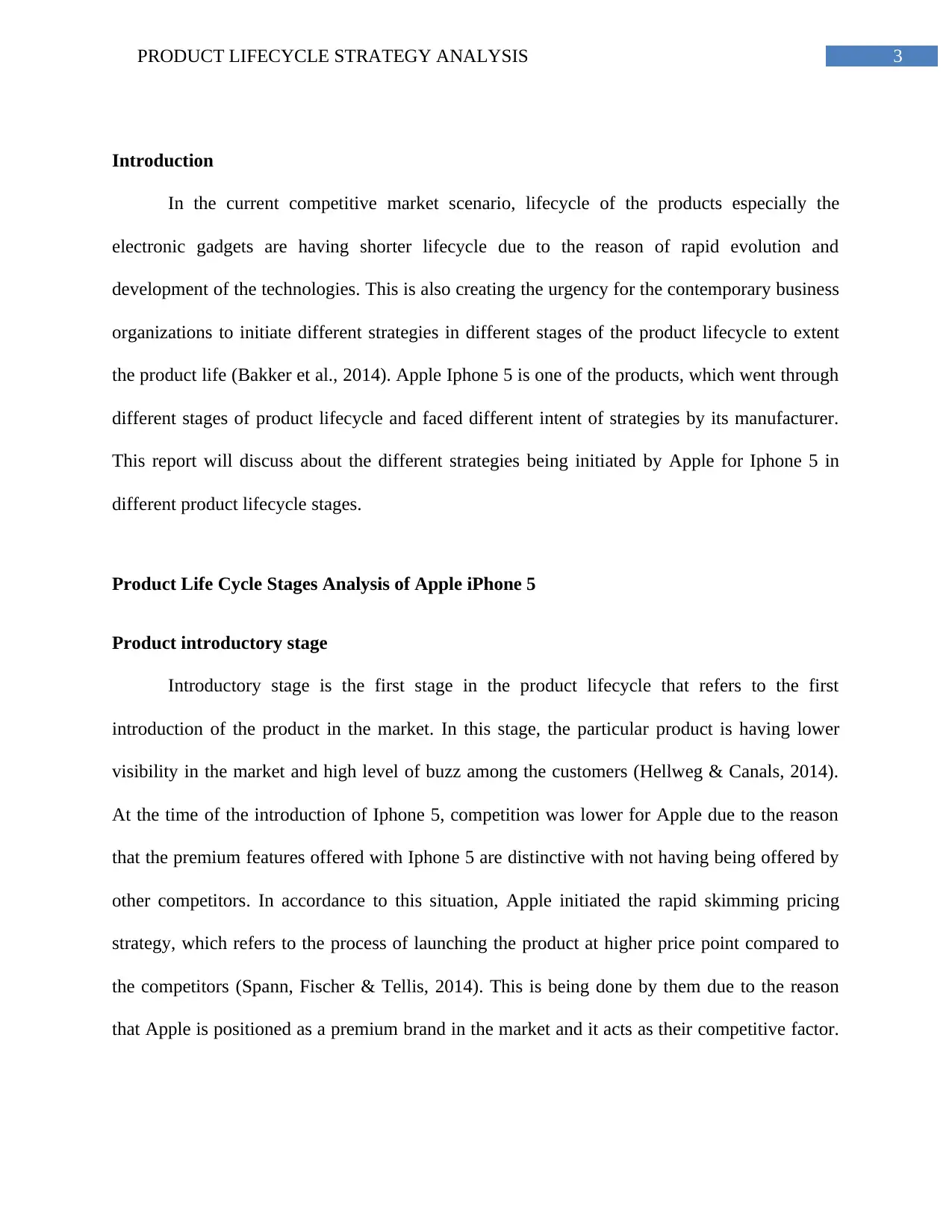
3PRODUCT LIFECYCLE STRATEGY ANALYSIS
Introduction
In the current competitive market scenario, lifecycle of the products especially the
electronic gadgets are having shorter lifecycle due to the reason of rapid evolution and
development of the technologies. This is also creating the urgency for the contemporary business
organizations to initiate different strategies in different stages of the product lifecycle to extent
the product life (Bakker et al., 2014). Apple Iphone 5 is one of the products, which went through
different stages of product lifecycle and faced different intent of strategies by its manufacturer.
This report will discuss about the different strategies being initiated by Apple for Iphone 5 in
different product lifecycle stages.
Product Life Cycle Stages Analysis of Apple iPhone 5
Product introductory stage
Introductory stage is the first stage in the product lifecycle that refers to the first
introduction of the product in the market. In this stage, the particular product is having lower
visibility in the market and high level of buzz among the customers (Hellweg & Canals, 2014).
At the time of the introduction of Iphone 5, competition was lower for Apple due to the reason
that the premium features offered with Iphone 5 are distinctive with not having being offered by
other competitors. In accordance to this situation, Apple initiated the rapid skimming pricing
strategy, which refers to the process of launching the product at higher price point compared to
the competitors (Spann, Fischer & Tellis, 2014). This is being done by them due to the reason
that Apple is positioned as a premium brand in the market and it acts as their competitive factor.
Introduction
In the current competitive market scenario, lifecycle of the products especially the
electronic gadgets are having shorter lifecycle due to the reason of rapid evolution and
development of the technologies. This is also creating the urgency for the contemporary business
organizations to initiate different strategies in different stages of the product lifecycle to extent
the product life (Bakker et al., 2014). Apple Iphone 5 is one of the products, which went through
different stages of product lifecycle and faced different intent of strategies by its manufacturer.
This report will discuss about the different strategies being initiated by Apple for Iphone 5 in
different product lifecycle stages.
Product Life Cycle Stages Analysis of Apple iPhone 5
Product introductory stage
Introductory stage is the first stage in the product lifecycle that refers to the first
introduction of the product in the market. In this stage, the particular product is having lower
visibility in the market and high level of buzz among the customers (Hellweg & Canals, 2014).
At the time of the introduction of Iphone 5, competition was lower for Apple due to the reason
that the premium features offered with Iphone 5 are distinctive with not having being offered by
other competitors. In accordance to this situation, Apple initiated the rapid skimming pricing
strategy, which refers to the process of launching the product at higher price point compared to
the competitors (Spann, Fischer & Tellis, 2014). This is being done by them due to the reason
that Apple is positioned as a premium brand in the market and it acts as their competitive factor.
Secure Best Marks with AI Grader
Need help grading? Try our AI Grader for instant feedback on your assignments.
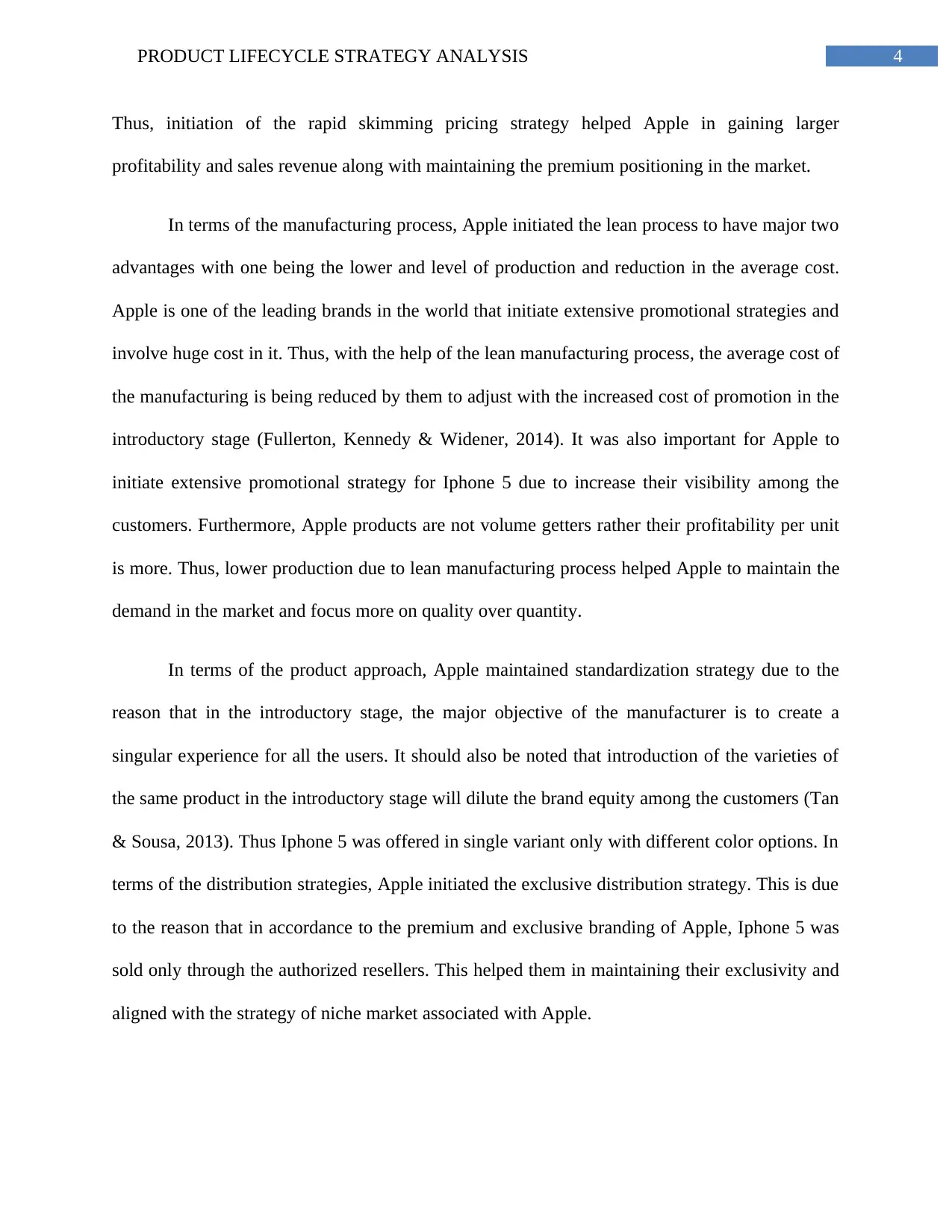
4PRODUCT LIFECYCLE STRATEGY ANALYSIS
Thus, initiation of the rapid skimming pricing strategy helped Apple in gaining larger
profitability and sales revenue along with maintaining the premium positioning in the market.
In terms of the manufacturing process, Apple initiated the lean process to have major two
advantages with one being the lower and level of production and reduction in the average cost.
Apple is one of the leading brands in the world that initiate extensive promotional strategies and
involve huge cost in it. Thus, with the help of the lean manufacturing process, the average cost of
the manufacturing is being reduced by them to adjust with the increased cost of promotion in the
introductory stage (Fullerton, Kennedy & Widener, 2014). It was also important for Apple to
initiate extensive promotional strategy for Iphone 5 due to increase their visibility among the
customers. Furthermore, Apple products are not volume getters rather their profitability per unit
is more. Thus, lower production due to lean manufacturing process helped Apple to maintain the
demand in the market and focus more on quality over quantity.
In terms of the product approach, Apple maintained standardization strategy due to the
reason that in the introductory stage, the major objective of the manufacturer is to create a
singular experience for all the users. It should also be noted that introduction of the varieties of
the same product in the introductory stage will dilute the brand equity among the customers (Tan
& Sousa, 2013). Thus Iphone 5 was offered in single variant only with different color options. In
terms of the distribution strategies, Apple initiated the exclusive distribution strategy. This is due
to the reason that in accordance to the premium and exclusive branding of Apple, Iphone 5 was
sold only through the authorized resellers. This helped them in maintaining their exclusivity and
aligned with the strategy of niche market associated with Apple.
Thus, initiation of the rapid skimming pricing strategy helped Apple in gaining larger
profitability and sales revenue along with maintaining the premium positioning in the market.
In terms of the manufacturing process, Apple initiated the lean process to have major two
advantages with one being the lower and level of production and reduction in the average cost.
Apple is one of the leading brands in the world that initiate extensive promotional strategies and
involve huge cost in it. Thus, with the help of the lean manufacturing process, the average cost of
the manufacturing is being reduced by them to adjust with the increased cost of promotion in the
introductory stage (Fullerton, Kennedy & Widener, 2014). It was also important for Apple to
initiate extensive promotional strategy for Iphone 5 due to increase their visibility among the
customers. Furthermore, Apple products are not volume getters rather their profitability per unit
is more. Thus, lower production due to lean manufacturing process helped Apple to maintain the
demand in the market and focus more on quality over quantity.
In terms of the product approach, Apple maintained standardization strategy due to the
reason that in the introductory stage, the major objective of the manufacturer is to create a
singular experience for all the users. It should also be noted that introduction of the varieties of
the same product in the introductory stage will dilute the brand equity among the customers (Tan
& Sousa, 2013). Thus Iphone 5 was offered in single variant only with different color options. In
terms of the distribution strategies, Apple initiated the exclusive distribution strategy. This is due
to the reason that in accordance to the premium and exclusive branding of Apple, Iphone 5 was
sold only through the authorized resellers. This helped them in maintaining their exclusivity and
aligned with the strategy of niche market associated with Apple.
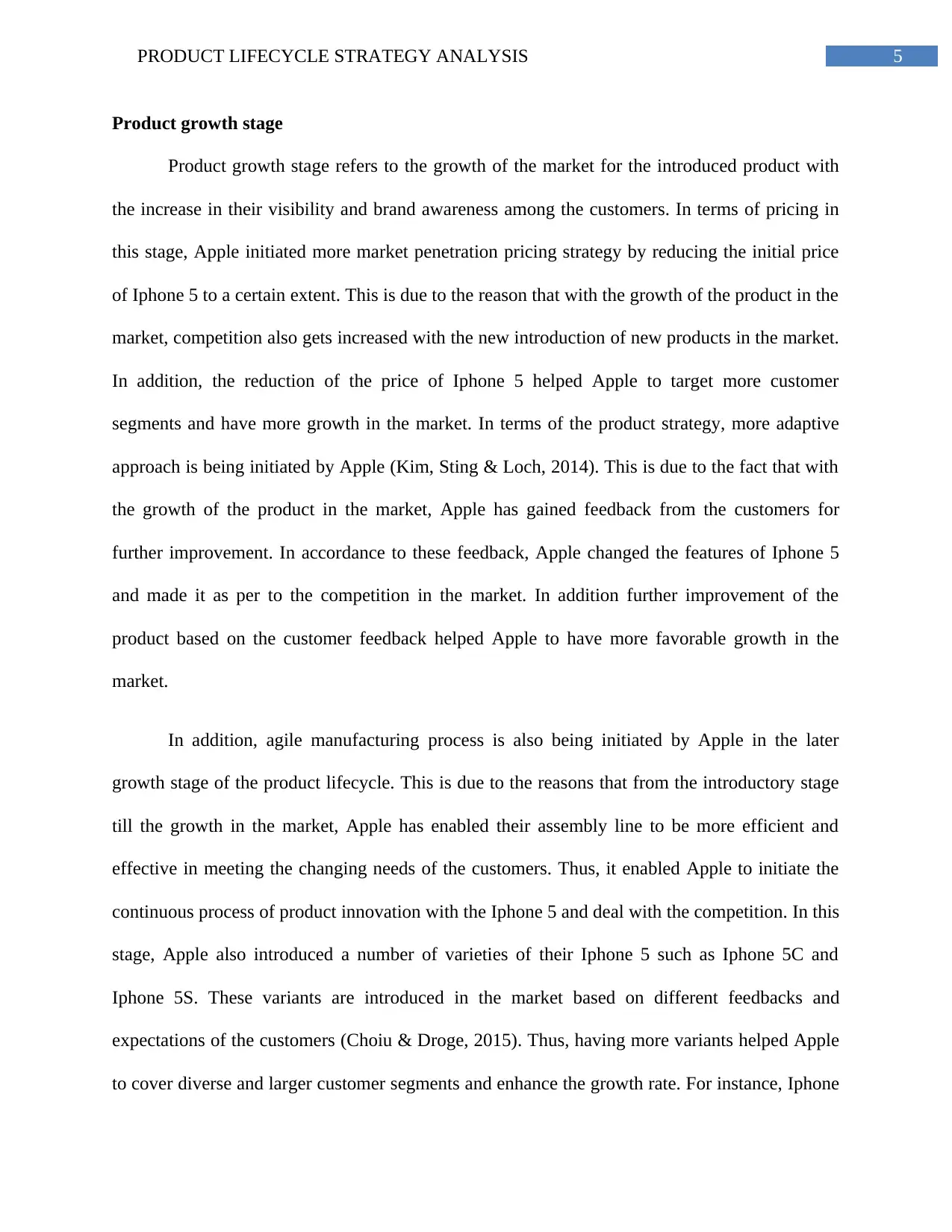
5PRODUCT LIFECYCLE STRATEGY ANALYSIS
Product growth stage
Product growth stage refers to the growth of the market for the introduced product with
the increase in their visibility and brand awareness among the customers. In terms of pricing in
this stage, Apple initiated more market penetration pricing strategy by reducing the initial price
of Iphone 5 to a certain extent. This is due to the reason that with the growth of the product in the
market, competition also gets increased with the new introduction of new products in the market.
In addition, the reduction of the price of Iphone 5 helped Apple to target more customer
segments and have more growth in the market. In terms of the product strategy, more adaptive
approach is being initiated by Apple (Kim, Sting & Loch, 2014). This is due to the fact that with
the growth of the product in the market, Apple has gained feedback from the customers for
further improvement. In accordance to these feedback, Apple changed the features of Iphone 5
and made it as per to the competition in the market. In addition further improvement of the
product based on the customer feedback helped Apple to have more favorable growth in the
market.
In addition, agile manufacturing process is also being initiated by Apple in the later
growth stage of the product lifecycle. This is due to the reasons that from the introductory stage
till the growth in the market, Apple has enabled their assembly line to be more efficient and
effective in meeting the changing needs of the customers. Thus, it enabled Apple to initiate the
continuous process of product innovation with the Iphone 5 and deal with the competition. In this
stage, Apple also introduced a number of varieties of their Iphone 5 such as Iphone 5C and
Iphone 5S. These variants are introduced in the market based on different feedbacks and
expectations of the customers (Choiu & Droge, 2015). Thus, having more variants helped Apple
to cover diverse and larger customer segments and enhance the growth rate. For instance, Iphone
Product growth stage
Product growth stage refers to the growth of the market for the introduced product with
the increase in their visibility and brand awareness among the customers. In terms of pricing in
this stage, Apple initiated more market penetration pricing strategy by reducing the initial price
of Iphone 5 to a certain extent. This is due to the reason that with the growth of the product in the
market, competition also gets increased with the new introduction of new products in the market.
In addition, the reduction of the price of Iphone 5 helped Apple to target more customer
segments and have more growth in the market. In terms of the product strategy, more adaptive
approach is being initiated by Apple (Kim, Sting & Loch, 2014). This is due to the fact that with
the growth of the product in the market, Apple has gained feedback from the customers for
further improvement. In accordance to these feedback, Apple changed the features of Iphone 5
and made it as per to the competition in the market. In addition further improvement of the
product based on the customer feedback helped Apple to have more favorable growth in the
market.
In addition, agile manufacturing process is also being initiated by Apple in the later
growth stage of the product lifecycle. This is due to the reasons that from the introductory stage
till the growth in the market, Apple has enabled their assembly line to be more efficient and
effective in meeting the changing needs of the customers. Thus, it enabled Apple to initiate the
continuous process of product innovation with the Iphone 5 and deal with the competition. In this
stage, Apple also introduced a number of varieties of their Iphone 5 such as Iphone 5C and
Iphone 5S. These variants are introduced in the market based on different feedbacks and
expectations of the customers (Choiu & Droge, 2015). Thus, having more variants helped Apple
to cover diverse and larger customer segments and enhance the growth rate. For instance, Iphone
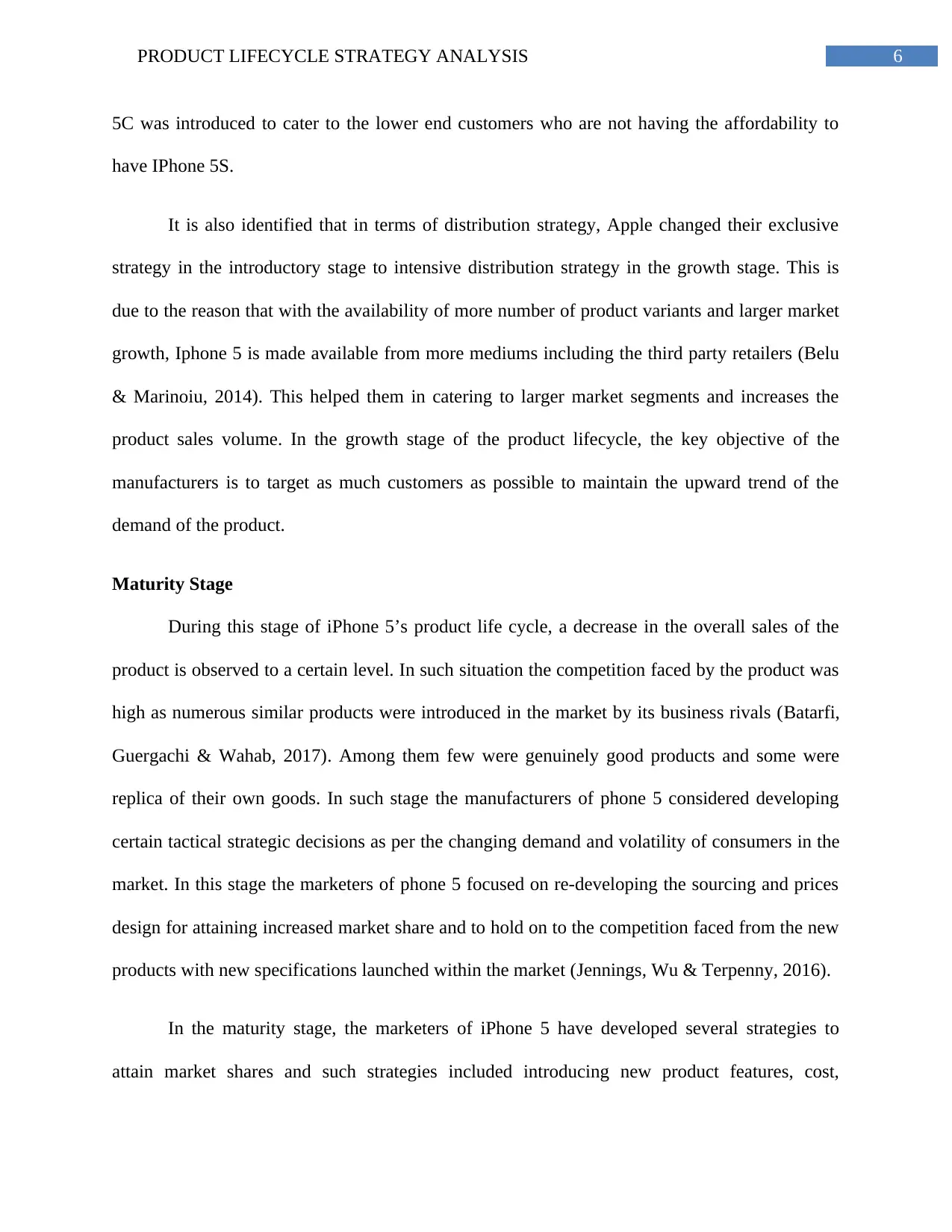
6PRODUCT LIFECYCLE STRATEGY ANALYSIS
5C was introduced to cater to the lower end customers who are not having the affordability to
have IPhone 5S.
It is also identified that in terms of distribution strategy, Apple changed their exclusive
strategy in the introductory stage to intensive distribution strategy in the growth stage. This is
due to the reason that with the availability of more number of product variants and larger market
growth, Iphone 5 is made available from more mediums including the third party retailers (Belu
& Marinoiu, 2014). This helped them in catering to larger market segments and increases the
product sales volume. In the growth stage of the product lifecycle, the key objective of the
manufacturers is to target as much customers as possible to maintain the upward trend of the
demand of the product.
Maturity Stage
During this stage of iPhone 5’s product life cycle, a decrease in the overall sales of the
product is observed to a certain level. In such situation the competition faced by the product was
high as numerous similar products were introduced in the market by its business rivals (Batarfi,
Guergachi & Wahab, 2017). Among them few were genuinely good products and some were
replica of their own goods. In such stage the manufacturers of phone 5 considered developing
certain tactical strategic decisions as per the changing demand and volatility of consumers in the
market. In this stage the marketers of phone 5 focused on re-developing the sourcing and prices
design for attaining increased market share and to hold on to the competition faced from the new
products with new specifications launched within the market (Jennings, Wu & Terpenny, 2016).
In the maturity stage, the marketers of iPhone 5 have developed several strategies to
attain market shares and such strategies included introducing new product features, cost,
5C was introduced to cater to the lower end customers who are not having the affordability to
have IPhone 5S.
It is also identified that in terms of distribution strategy, Apple changed their exclusive
strategy in the introductory stage to intensive distribution strategy in the growth stage. This is
due to the reason that with the availability of more number of product variants and larger market
growth, Iphone 5 is made available from more mediums including the third party retailers (Belu
& Marinoiu, 2014). This helped them in catering to larger market segments and increases the
product sales volume. In the growth stage of the product lifecycle, the key objective of the
manufacturers is to target as much customers as possible to maintain the upward trend of the
demand of the product.
Maturity Stage
During this stage of iPhone 5’s product life cycle, a decrease in the overall sales of the
product is observed to a certain level. In such situation the competition faced by the product was
high as numerous similar products were introduced in the market by its business rivals (Batarfi,
Guergachi & Wahab, 2017). Among them few were genuinely good products and some were
replica of their own goods. In such stage the manufacturers of phone 5 considered developing
certain tactical strategic decisions as per the changing demand and volatility of consumers in the
market. In this stage the marketers of phone 5 focused on re-developing the sourcing and prices
design for attaining increased market share and to hold on to the competition faced from the new
products with new specifications launched within the market (Jennings, Wu & Terpenny, 2016).
In the maturity stage, the marketers of iPhone 5 have developed several strategies to
attain market shares and such strategies included introducing new product features, cost,
Paraphrase This Document
Need a fresh take? Get an instant paraphrase of this document with our AI Paraphraser
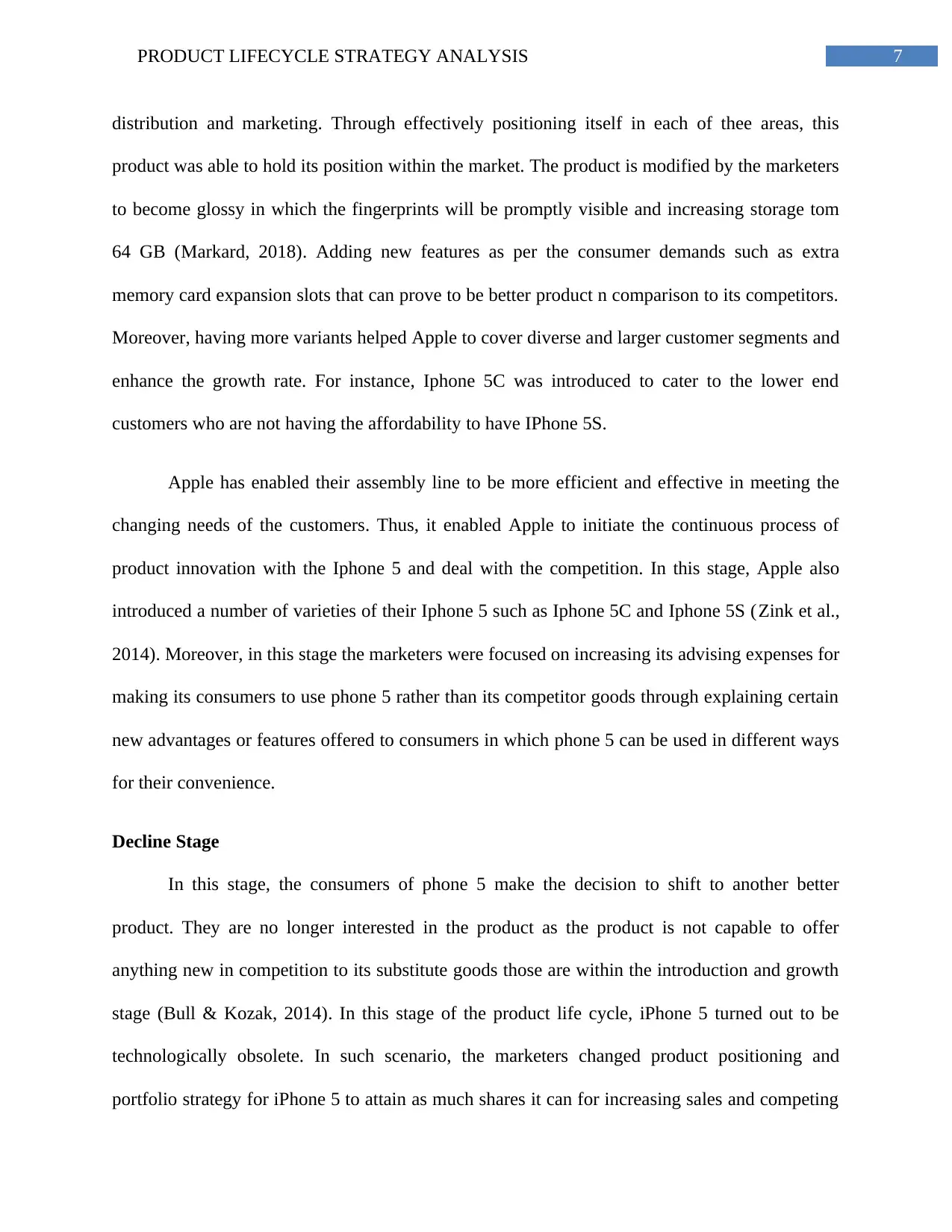
7PRODUCT LIFECYCLE STRATEGY ANALYSIS
distribution and marketing. Through effectively positioning itself in each of thee areas, this
product was able to hold its position within the market. The product is modified by the marketers
to become glossy in which the fingerprints will be promptly visible and increasing storage tom
64 GB (Markard, 2018). Adding new features as per the consumer demands such as extra
memory card expansion slots that can prove to be better product n comparison to its competitors.
Moreover, having more variants helped Apple to cover diverse and larger customer segments and
enhance the growth rate. For instance, Iphone 5C was introduced to cater to the lower end
customers who are not having the affordability to have IPhone 5S.
Apple has enabled their assembly line to be more efficient and effective in meeting the
changing needs of the customers. Thus, it enabled Apple to initiate the continuous process of
product innovation with the Iphone 5 and deal with the competition. In this stage, Apple also
introduced a number of varieties of their Iphone 5 such as Iphone 5C and Iphone 5S (Zink et al.,
2014). Moreover, in this stage the marketers were focused on increasing its advising expenses for
making its consumers to use phone 5 rather than its competitor goods through explaining certain
new advantages or features offered to consumers in which phone 5 can be used in different ways
for their convenience.
Decline Stage
In this stage, the consumers of phone 5 make the decision to shift to another better
product. They are no longer interested in the product as the product is not capable to offer
anything new in competition to its substitute goods those are within the introduction and growth
stage (Bull & Kozak, 2014). In this stage of the product life cycle, iPhone 5 turned out to be
technologically obsolete. In such scenario, the marketers changed product positioning and
portfolio strategy for iPhone 5 to attain as much shares it can for increasing sales and competing
distribution and marketing. Through effectively positioning itself in each of thee areas, this
product was able to hold its position within the market. The product is modified by the marketers
to become glossy in which the fingerprints will be promptly visible and increasing storage tom
64 GB (Markard, 2018). Adding new features as per the consumer demands such as extra
memory card expansion slots that can prove to be better product n comparison to its competitors.
Moreover, having more variants helped Apple to cover diverse and larger customer segments and
enhance the growth rate. For instance, Iphone 5C was introduced to cater to the lower end
customers who are not having the affordability to have IPhone 5S.
Apple has enabled their assembly line to be more efficient and effective in meeting the
changing needs of the customers. Thus, it enabled Apple to initiate the continuous process of
product innovation with the Iphone 5 and deal with the competition. In this stage, Apple also
introduced a number of varieties of their Iphone 5 such as Iphone 5C and Iphone 5S (Zink et al.,
2014). Moreover, in this stage the marketers were focused on increasing its advising expenses for
making its consumers to use phone 5 rather than its competitor goods through explaining certain
new advantages or features offered to consumers in which phone 5 can be used in different ways
for their convenience.
Decline Stage
In this stage, the consumers of phone 5 make the decision to shift to another better
product. They are no longer interested in the product as the product is not capable to offer
anything new in competition to its substitute goods those are within the introduction and growth
stage (Bull & Kozak, 2014). In this stage of the product life cycle, iPhone 5 turned out to be
technologically obsolete. In such scenario, the marketers changed product positioning and
portfolio strategy for iPhone 5 to attain as much shares it can for increasing sales and competing
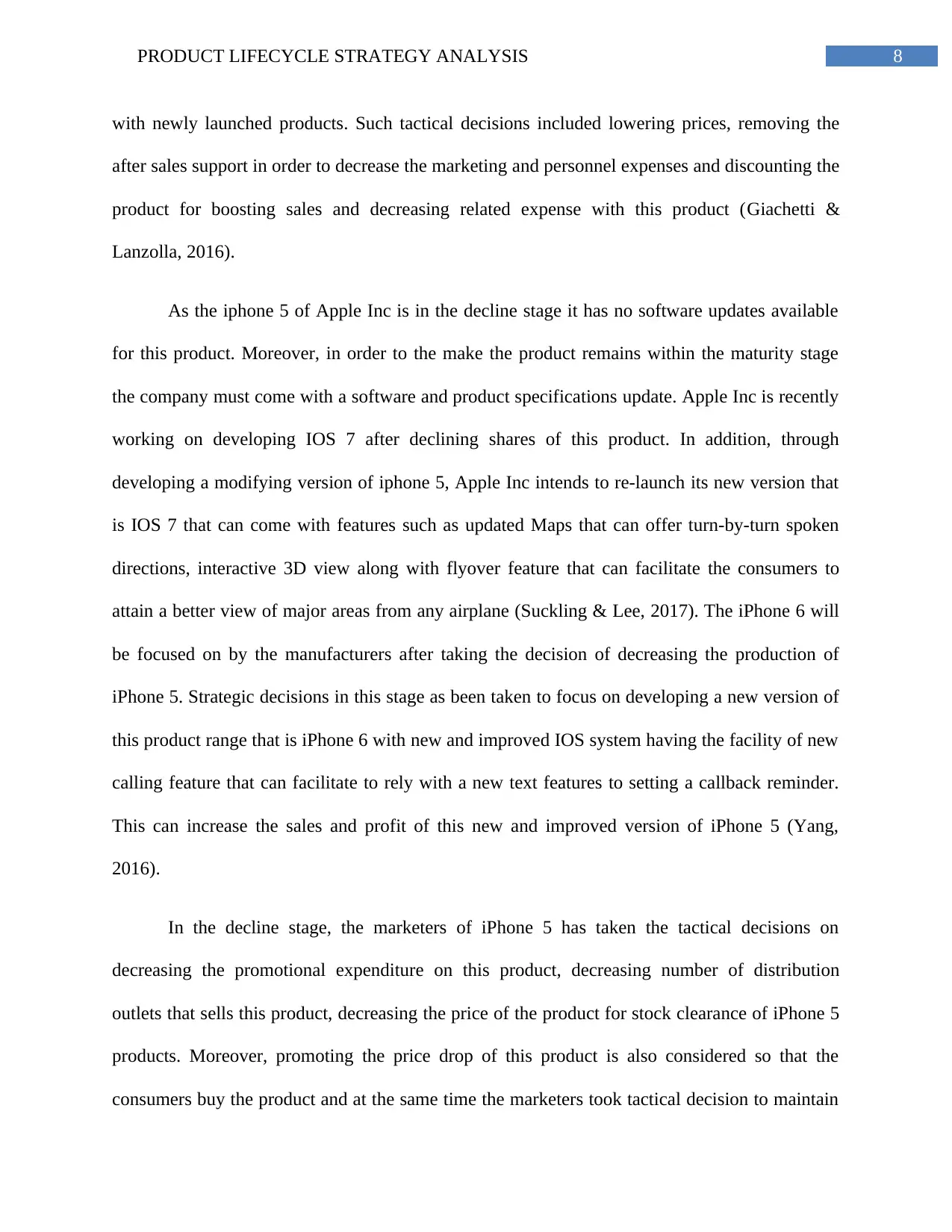
8PRODUCT LIFECYCLE STRATEGY ANALYSIS
with newly launched products. Such tactical decisions included lowering prices, removing the
after sales support in order to decrease the marketing and personnel expenses and discounting the
product for boosting sales and decreasing related expense with this product (Giachetti &
Lanzolla, 2016).
As the iphone 5 of Apple Inc is in the decline stage it has no software updates available
for this product. Moreover, in order to the make the product remains within the maturity stage
the company must come with a software and product specifications update. Apple Inc is recently
working on developing IOS 7 after declining shares of this product. In addition, through
developing a modifying version of iphone 5, Apple Inc intends to re-launch its new version that
is IOS 7 that can come with features such as updated Maps that can offer turn-by-turn spoken
directions, interactive 3D view along with flyover feature that can facilitate the consumers to
attain a better view of major areas from any airplane (Suckling & Lee, 2017). The iPhone 6 will
be focused on by the manufacturers after taking the decision of decreasing the production of
iPhone 5. Strategic decisions in this stage as been taken to focus on developing a new version of
this product range that is iPhone 6 with new and improved IOS system having the facility of new
calling feature that can facilitate to rely with a new text features to setting a callback reminder.
This can increase the sales and profit of this new and improved version of iPhone 5 (Yang,
2016).
In the decline stage, the marketers of iPhone 5 has taken the tactical decisions on
decreasing the promotional expenditure on this product, decreasing number of distribution
outlets that sells this product, decreasing the price of the product for stock clearance of iPhone 5
products. Moreover, promoting the price drop of this product is also considered so that the
consumers buy the product and at the same time the marketers took tactical decision to maintain
with newly launched products. Such tactical decisions included lowering prices, removing the
after sales support in order to decrease the marketing and personnel expenses and discounting the
product for boosting sales and decreasing related expense with this product (Giachetti &
Lanzolla, 2016).
As the iphone 5 of Apple Inc is in the decline stage it has no software updates available
for this product. Moreover, in order to the make the product remains within the maturity stage
the company must come with a software and product specifications update. Apple Inc is recently
working on developing IOS 7 after declining shares of this product. In addition, through
developing a modifying version of iphone 5, Apple Inc intends to re-launch its new version that
is IOS 7 that can come with features such as updated Maps that can offer turn-by-turn spoken
directions, interactive 3D view along with flyover feature that can facilitate the consumers to
attain a better view of major areas from any airplane (Suckling & Lee, 2017). The iPhone 6 will
be focused on by the manufacturers after taking the decision of decreasing the production of
iPhone 5. Strategic decisions in this stage as been taken to focus on developing a new version of
this product range that is iPhone 6 with new and improved IOS system having the facility of new
calling feature that can facilitate to rely with a new text features to setting a callback reminder.
This can increase the sales and profit of this new and improved version of iPhone 5 (Yang,
2016).
In the decline stage, the marketers of iPhone 5 has taken the tactical decisions on
decreasing the promotional expenditure on this product, decreasing number of distribution
outlets that sells this product, decreasing the price of the product for stock clearance of iPhone 5
products. Moreover, promoting the price drop of this product is also considered so that the
consumers buy the product and at the same time the marketers took tactical decision to maintain
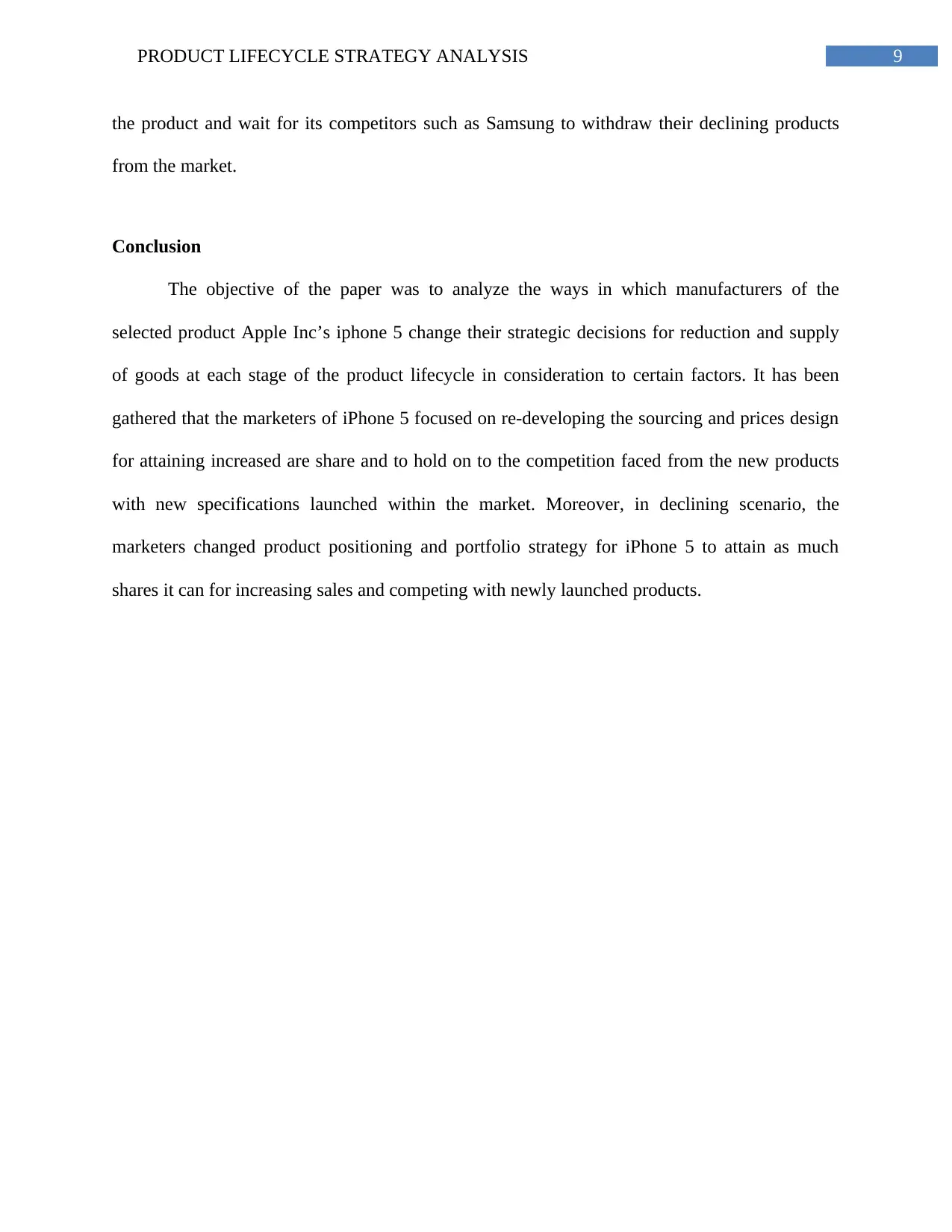
9PRODUCT LIFECYCLE STRATEGY ANALYSIS
the product and wait for its competitors such as Samsung to withdraw their declining products
from the market.
Conclusion
The objective of the paper was to analyze the ways in which manufacturers of the
selected product Apple Inc’s iphone 5 change their strategic decisions for reduction and supply
of goods at each stage of the product lifecycle in consideration to certain factors. It has been
gathered that the marketers of iPhone 5 focused on re-developing the sourcing and prices design
for attaining increased are share and to hold on to the competition faced from the new products
with new specifications launched within the market. Moreover, in declining scenario, the
marketers changed product positioning and portfolio strategy for iPhone 5 to attain as much
shares it can for increasing sales and competing with newly launched products.
the product and wait for its competitors such as Samsung to withdraw their declining products
from the market.
Conclusion
The objective of the paper was to analyze the ways in which manufacturers of the
selected product Apple Inc’s iphone 5 change their strategic decisions for reduction and supply
of goods at each stage of the product lifecycle in consideration to certain factors. It has been
gathered that the marketers of iPhone 5 focused on re-developing the sourcing and prices design
for attaining increased are share and to hold on to the competition faced from the new products
with new specifications launched within the market. Moreover, in declining scenario, the
marketers changed product positioning and portfolio strategy for iPhone 5 to attain as much
shares it can for increasing sales and competing with newly launched products.
Secure Best Marks with AI Grader
Need help grading? Try our AI Grader for instant feedback on your assignments.
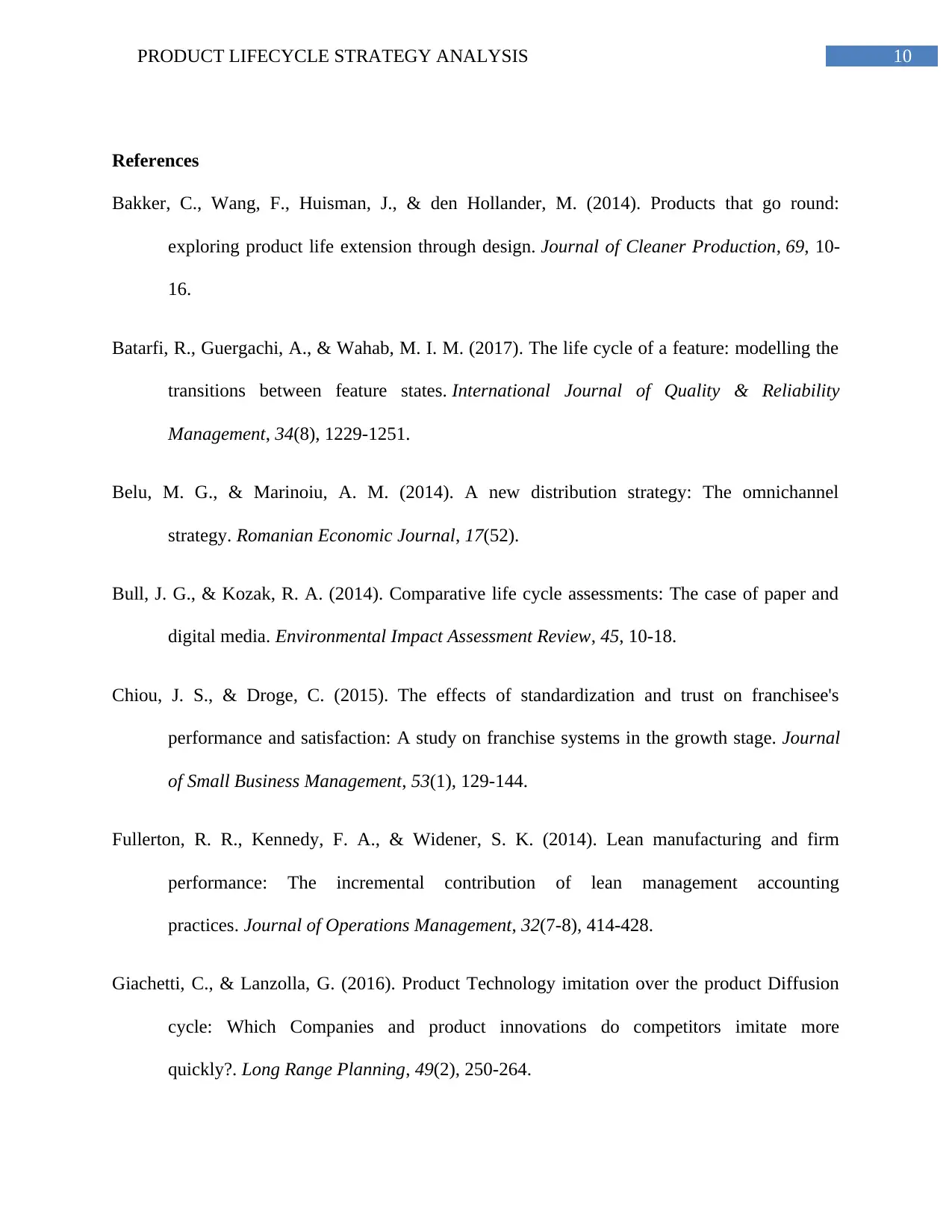
10PRODUCT LIFECYCLE STRATEGY ANALYSIS
References
Bakker, C., Wang, F., Huisman, J., & den Hollander, M. (2014). Products that go round:
exploring product life extension through design. Journal of Cleaner Production, 69, 10-
16.
Batarfi, R., Guergachi, A., & Wahab, M. I. M. (2017). The life cycle of a feature: modelling the
transitions between feature states. International Journal of Quality & Reliability
Management, 34(8), 1229-1251.
Belu, M. G., & Marinoiu, A. M. (2014). A new distribution strategy: The omnichannel
strategy. Romanian Economic Journal, 17(52).
Bull, J. G., & Kozak, R. A. (2014). Comparative life cycle assessments: The case of paper and
digital media. Environmental Impact Assessment Review, 45, 10-18.
Chiou, J. S., & Droge, C. (2015). The effects of standardization and trust on franchisee's
performance and satisfaction: A study on franchise systems in the growth stage. Journal
of Small Business Management, 53(1), 129-144.
Fullerton, R. R., Kennedy, F. A., & Widener, S. K. (2014). Lean manufacturing and firm
performance: The incremental contribution of lean management accounting
practices. Journal of Operations Management, 32(7-8), 414-428.
Giachetti, C., & Lanzolla, G. (2016). Product Technology imitation over the product Diffusion
cycle: Which Companies and product innovations do competitors imitate more
quickly?. Long Range Planning, 49(2), 250-264.
References
Bakker, C., Wang, F., Huisman, J., & den Hollander, M. (2014). Products that go round:
exploring product life extension through design. Journal of Cleaner Production, 69, 10-
16.
Batarfi, R., Guergachi, A., & Wahab, M. I. M. (2017). The life cycle of a feature: modelling the
transitions between feature states. International Journal of Quality & Reliability
Management, 34(8), 1229-1251.
Belu, M. G., & Marinoiu, A. M. (2014). A new distribution strategy: The omnichannel
strategy. Romanian Economic Journal, 17(52).
Bull, J. G., & Kozak, R. A. (2014). Comparative life cycle assessments: The case of paper and
digital media. Environmental Impact Assessment Review, 45, 10-18.
Chiou, J. S., & Droge, C. (2015). The effects of standardization and trust on franchisee's
performance and satisfaction: A study on franchise systems in the growth stage. Journal
of Small Business Management, 53(1), 129-144.
Fullerton, R. R., Kennedy, F. A., & Widener, S. K. (2014). Lean manufacturing and firm
performance: The incremental contribution of lean management accounting
practices. Journal of Operations Management, 32(7-8), 414-428.
Giachetti, C., & Lanzolla, G. (2016). Product Technology imitation over the product Diffusion
cycle: Which Companies and product innovations do competitors imitate more
quickly?. Long Range Planning, 49(2), 250-264.
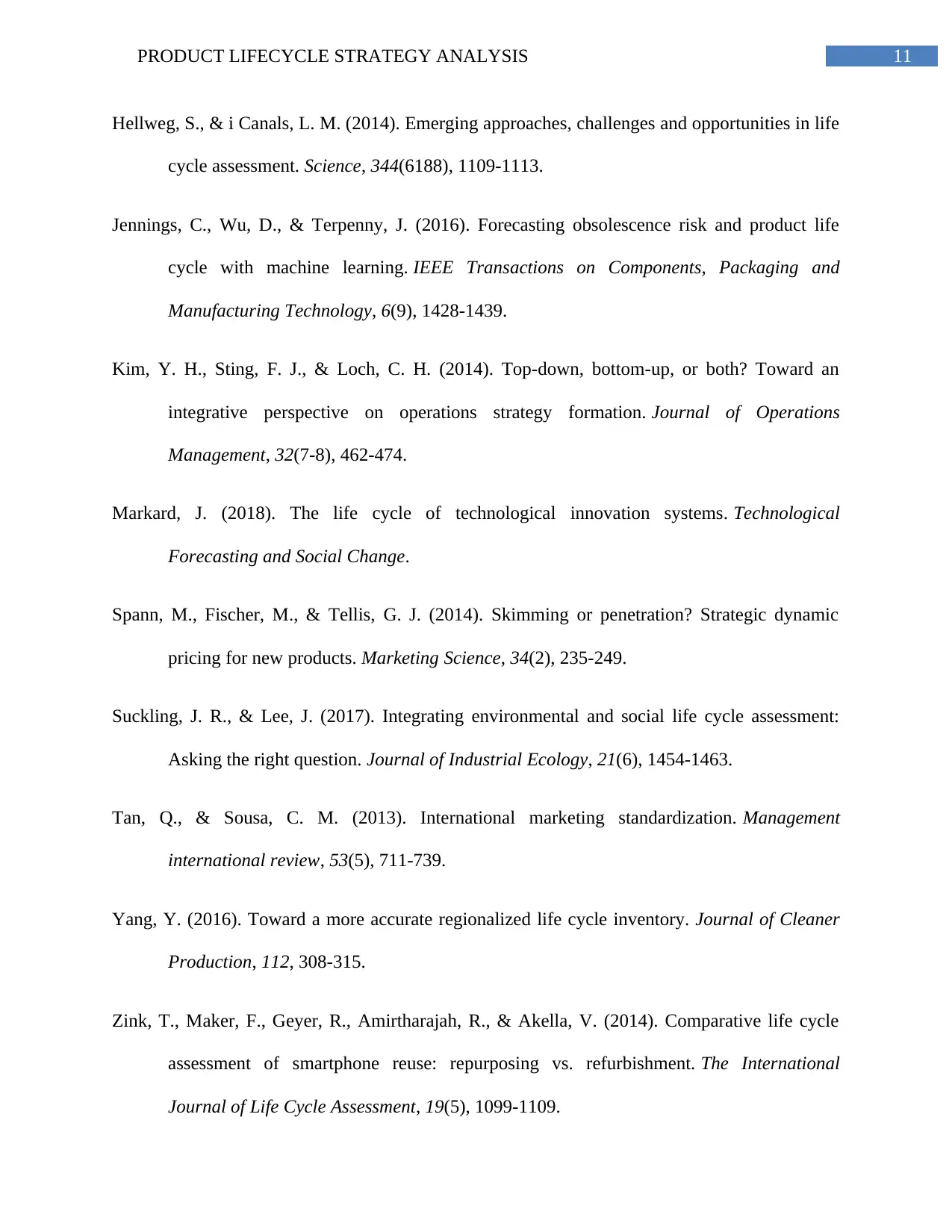
11PRODUCT LIFECYCLE STRATEGY ANALYSIS
Hellweg, S., & i Canals, L. M. (2014). Emerging approaches, challenges and opportunities in life
cycle assessment. Science, 344(6188), 1109-1113.
Jennings, C., Wu, D., & Terpenny, J. (2016). Forecasting obsolescence risk and product life
cycle with machine learning. IEEE Transactions on Components, Packaging and
Manufacturing Technology, 6(9), 1428-1439.
Kim, Y. H., Sting, F. J., & Loch, C. H. (2014). Top-down, bottom-up, or both? Toward an
integrative perspective on operations strategy formation. Journal of Operations
Management, 32(7-8), 462-474.
Markard, J. (2018). The life cycle of technological innovation systems. Technological
Forecasting and Social Change.
Spann, M., Fischer, M., & Tellis, G. J. (2014). Skimming or penetration? Strategic dynamic
pricing for new products. Marketing Science, 34(2), 235-249.
Suckling, J. R., & Lee, J. (2017). Integrating environmental and social life cycle assessment:
Asking the right question. Journal of Industrial Ecology, 21(6), 1454-1463.
Tan, Q., & Sousa, C. M. (2013). International marketing standardization. Management
international review, 53(5), 711-739.
Yang, Y. (2016). Toward a more accurate regionalized life cycle inventory. Journal of Cleaner
Production, 112, 308-315.
Zink, T., Maker, F., Geyer, R., Amirtharajah, R., & Akella, V. (2014). Comparative life cycle
assessment of smartphone reuse: repurposing vs. refurbishment. The International
Journal of Life Cycle Assessment, 19(5), 1099-1109.
Hellweg, S., & i Canals, L. M. (2014). Emerging approaches, challenges and opportunities in life
cycle assessment. Science, 344(6188), 1109-1113.
Jennings, C., Wu, D., & Terpenny, J. (2016). Forecasting obsolescence risk and product life
cycle with machine learning. IEEE Transactions on Components, Packaging and
Manufacturing Technology, 6(9), 1428-1439.
Kim, Y. H., Sting, F. J., & Loch, C. H. (2014). Top-down, bottom-up, or both? Toward an
integrative perspective on operations strategy formation. Journal of Operations
Management, 32(7-8), 462-474.
Markard, J. (2018). The life cycle of technological innovation systems. Technological
Forecasting and Social Change.
Spann, M., Fischer, M., & Tellis, G. J. (2014). Skimming or penetration? Strategic dynamic
pricing for new products. Marketing Science, 34(2), 235-249.
Suckling, J. R., & Lee, J. (2017). Integrating environmental and social life cycle assessment:
Asking the right question. Journal of Industrial Ecology, 21(6), 1454-1463.
Tan, Q., & Sousa, C. M. (2013). International marketing standardization. Management
international review, 53(5), 711-739.
Yang, Y. (2016). Toward a more accurate regionalized life cycle inventory. Journal of Cleaner
Production, 112, 308-315.
Zink, T., Maker, F., Geyer, R., Amirtharajah, R., & Akella, V. (2014). Comparative life cycle
assessment of smartphone reuse: repurposing vs. refurbishment. The International
Journal of Life Cycle Assessment, 19(5), 1099-1109.
1 out of 12
Related Documents
Your All-in-One AI-Powered Toolkit for Academic Success.
+13062052269
info@desklib.com
Available 24*7 on WhatsApp / Email
![[object Object]](/_next/static/media/star-bottom.7253800d.svg)
Unlock your academic potential
© 2024 | Zucol Services PVT LTD | All rights reserved.




